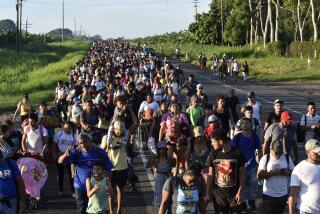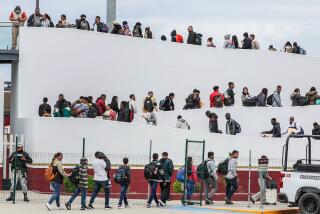Freedom Elusive for Refugees Fleeing to U.S.
- Share via
WASHINGTON — An Afghan medical student spent three months behind bars in a New York detention center in 1998. She was strip-searched, shackled, then kept in a room for 23 hours a day.
The reason: She had fled the Taliban without any identity documents and sought asylum in the United States.
“Of course, I was not expecting them to let me go right away because I did not have any documents,” she said in an interview last week from her Baltimore home. “I did not expect them to shackle me like a criminal.”
She eventually won asylum, but not before encountering an unforgiving U.S. immigration system that treats most newcomers harshly.
America’s immigration policies have come under fire in recent months for the treatment of hundreds of foreigners picked up by authorities investigating the Sept. 11 terrorist attacks. Advocates and detainees have complained about lengthy detentions, delays, secrecy and lack of legal representation.
But, as the Afghan student’s case illustrates, those problems aren’t unique to the Sept. 11 detainees. They are endemic in a process that gives few legal protections to noncitizens who are in the U.S. illegally, whether they came to seek political asylum or overstayed a visa.
Now advocates for immigrants fear already tough conditions will worsen for them as the government girds itself against future terrorist attacks.
“The political environment has changed overnight. It really set us back years,” said Wendy Young, director of government relations for the Women’s Commission for Refugee Women and Children. “Somehow, as a country we have to differentiate between people coming here for the wrong reasons and people who are seeking refuge or to rejoin family.”
Atty. Gen. John Ashcroft has said his office is trying to strike a balance between national security interests and the rights of the detainees. “Our efforts have been carefully crafted to avoid infringing on constitutional rights while saving American lives,” he told the Senate Judiciary Committee.
After the 1993 World Trade Center bombers abused asylum laws to stay in the U.S., Congress tightened the laws and began detaining more asylum-seekers.
Advocates complain that immigration laws have been carried out in an arbitrary and often punitive manner since then. Although the federal government sets the laws, Immigration and Naturalization Service districts across the country have their own rules for detention. Depending on where immigrants are caught by the INS, they may be detained for days, months, years--or not at all.
“What’s happened after Sept. 11 has exposed flaws in the process of immigration adjudication that the public simply wasn’t aware of,” said Margaret Taylor, an immigration law professor at Wake Forest University in North Carolina.
Nearly all of the Sept. 11 detainees being held on immigration violations will end up in immigration court in what are called removal proceedings. Most are likely to be ordered out of the country. A Los Angeles Times study last spring of 1.2 million Immigration Court cases filed from 1994 to 2000 showed that 9 out of 10 cases ended with deportation orders.
The immigrants’ cases are decided in a process that doesn’t carry the full portfolio of rights that defendants would have in criminal court proceedings. They appear before Immigration Court judges who are employed by the Justice Department rather than the court system.
Because there is no right to a government lawyer, most immigrants go without one. The only record of the hearing is a tape recording kept by the judge. The testimony of witnesses is not usually translated for the benefit of non-English speakers.
“You’d rather be charged with a serious murder where you have rights than a visa overstay,” said Kerry Bretz, a New York immigration lawyer who has represented immigrants detained before Sept. 11 as well as those caught in the dragnet. “Because it’s civil in nature, the safeguards don’t apply.”
‘Insufficient Safeguards to Ensure Due Process’
The Afghan student learned the hard way that she had few rights under U.S. immigration laws. When the INS refused to parole her from detention, even though she had a sister in Maryland who is a U.S. citizen, she could not appeal the decision.
“It shows one of the problems that existed pre-Sept. 11 and is still there,” said Eleanor Acer, coordinator of the asylum program for the Lawyers Committee for Human Rights, who eventually helped the student win asylum. “There are insufficient safeguards to ensure due process.”
The student testified about her ordeal under an assumed name before a congressional subcommittee in May. She asked not to be identified in this story for fear that her family in Afghanistan would not be safe.
Her saga began in October 1998 when she arrived at John F. Kennedy airport in New York without any identity documents. Her name was so well-known to the Taliban--she had run a school for girls--that she feared carrying her papers would put her life in danger, she said.
“I fled the Taliban because they made life very hard for me. My life was not safe,” she said in an interview. “Nobody wants to do something illegal. I had no choice. I could either die there or choose” to enter the U.S. illegally.
She said an INS officer at the airport interviewed her, then ordered her to take off her clothes. She was so scared, she fainted. “From the culture I come from, it’s very hard for me to change my clothes in front of my sisters,” she said.
While in detention at the INS Wackenhut facility near the airport, she said she was treated like a criminal. She had to wear an orange prison uniform and was allowed outside just one hour a day. The outdoor recreation area is an internal courtyard; inmates view the sky through a fenced-in roof.
She was freed after 3 1/2 months. “Thank God, it wasn’t that long for me,” she said last week. “There were women from other countries who had spent two years there. They had to stay there. They had no other choice.”
Oluwole Aboyade, a 23-year-old Nigerian asylum-seeker, spent almost four years in INS detention centers in New Jersey and Pennsylvania before being released in September. Like some of the Sept. 11 detainees, Aboyade was moved from jail to jail. Aboyade complained of abuse, and a subsequent INS investigation substantiated his claims. Guards at one point put him in a cell covered with feces. He said he was beaten and kept in solitary confinement, sometimes without blankets or sheets.
Aboyade represented himself for most of the time he was detained. “A foolhardy exercise,” said Robert Ritchie, the Knoxville, Tenn., attorney who ended up taking the case pro bono. Aboyade was within “a few days” of deportation when Ritchie was able to win him a stay. On Sept. 7, Immigration Judge Mirlande Tadal ruled that Aboyade qualified for release under provisions of the United Nations torture convention.
The Times computer study found that 59% of immigrants like Aboyade did not have legal representation during immigration court proceedings. Yet those with attorneys were 17 times more likely to win relief in immigration court.
The study, published earlier this year, found that justice in immigration court was often arbitrary. The chances of staying in the U.S. often depended as much on who the judge was as the facts of the case. Some judges rarely granted asylum while others granted it liberally.
For example, in the period studied by The Times, 53% of the applicants from Afghanistan were granted asylum. But the chances of success were considerably lower for those assigned to the courtroom of New York Immigration Judge Sandy Hom. He heard 20 asylum claims from Afghans but granted just three. Overall, Hom granted asylum to 7% of the applicants in his courtroom; the national average is 14%.
In 1997, he rejected an asylum claim from a mother and three school-age daughters who said they would be persecuted by the Taliban because she was an Afghan with liberal views. The last the woman knew of her husband, he had been arrested. She presumed he was dead. Her brother and brother-in-law had been killed before the Taliban’s takeover, leaving them no male relatives.
Life for women under Taliban rule was harsh. They could not leave their homes without a male relative, school was banned, medical care scarce. They were forced to wear burkas, a tent-like garment covering them from head to toe. Failure to obey the rules could result in beatings or death.
Judge Hom did not appear to understand the severity of restrictions on women there. Referring incorrectly to the “Talisban,” he wrote in his decision that “the most that emerges from applicants’ testimony is that they would find the religious and social requirements objectionable and would not observe them if they could avoid doing so.”
Hom also wrote that the mother’s passport photo, which showed her in traditional Islamic garb--but not a burka--indicated that she “did not find the restrictive dress code to be abhorrent or adverse to her.”
Hom denied their claim and ordered them deported.
But when a number of respected immigration professors filed briefs in support of an appeal, calling the judge’s comments about the passport photo “patently absurd,” the INS withdrew its opposition and the family was granted asylum.
The mother and her children did not want to be identified or interviewed.
Process Aims for Independent Decisions
Judges are banned from commenting on individual decisions. They work for the Executive Office for Immigration Review, an arm of the Justice Department separated from the INS in 1983 to ensure independent decision-making.
Chief Immigration Judge Michael J. Creppy says each immigration case should be judged on its own merits and that disparities in judicial decision-making are to be expected. He has acknowledged that too many immigrants are unrepresented and has instituted a program to help provide them with pro bono lawyers.
Decisions by immigration judges can be appealed to the Board of Immigration Appeals. But there are about 57,000 cases pending before the board; it will take at least three years to hear them all. Nearly 9,000 immigrants will remain in detention until their appeals are heard.
After the terrorist attacks, Ashcroft announced that he wanted to “restructure the EOIR and streamline its processes to improve its organizational effectiveness and eliminate all case backlog.” The Justice Department offered no details of what he has in mind for the immigration courts but said a plan would be ready in six months.
Ashcroft has already used his broad discretion to make the immigration system tougher in response to the Sept. 11 attacks. He gave the INS the right to immediately override immigration judges’ orders releasing Sept. 11 detainees on bonds. As of early December, there were 560 Sept. 11 detainees in custody on immigration charges.
Federal regulations give immigration judges the right to close hearings on a case-by-case basis. But Ashcroft has mandated that all Sept. 11 cases be conducted in secret for national security reasons.
“The courtroom must be closed for these cases--no visitors, no family and no press,” Creppy wrote in a Sept. 21 memo to all immigration judges that was labeled “Please Do Not Disclose.”
The Creppy memo also dictated that only those judges with secret clearances be allowed to hear the Sept. 11 cases “because some of these cases may ultimately involve classified evidence.” Federal regulations already provide rules for how judges should handle classified evidence, however, and a secret clearance is not required.
Only 122 of the approximately 220 immigration judges have a secret clearance, and 79 already had it before becoming a judge, an indication they previously had worked for the Justice Department, INS or military. Statistically, judges who previously worked for the INS tend to more often rule against immigrants, the Times computer study showed.
Before Sept. 11, advocates were finding sympathy in Congress to reform immigration laws. Even President Bush had campaigned against the use of secret evidence in such cases. The attacks have changed all that.
Lori Nessel, an immigration law professor at Seton Hall Law School in New Jersey, recently represented an asylum-seeker from the Congo who had no documents to prove his identity. The INS trial attorney brought up Sept. 11 during the hearing, urging the judge to be skeptical.
“There is this fear that they’re going to be terrorists,” Nessel said. “It’s going to make it so much harder for asylum-seekers.”
More to Read
Sign up for Essential California
The most important California stories and recommendations in your inbox every morning.
You may occasionally receive promotional content from the Los Angeles Times.










